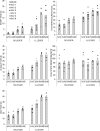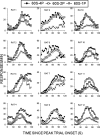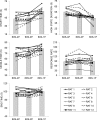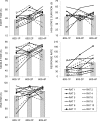Individual differences in impulsive choice and timing in rats
- PMID: 22851792
- PMCID: PMC3408726
- DOI: 10.1901/jeab.2012.98-65
Individual differences in impulsive choice and timing in rats
Abstract
Individual differences in impulsive choice behavior have been linked to a variety of behavioral problems including substance abuse, smoking, gambling, and poor financial decision-making. Given the potential importance of individual differences in impulsive choice as a predictor of behavioral problems, the present study sought to measure the extent of individual differences in a normal sample of hooded Lister rats. Three experiments utilized variations of a delay discounting task to measure the degree of variation in impulsive choice behavior across individual rats. The individual differences accounted for 22-55% of the variance in choice behavior across the three experiments. In Experiments 2 and 3, the individual differences were still apparent when behavior was measured across multiple choice points. Large individual differences in the rate of responding, and modest individual differences in timing of responding were also observed during occasional peak trials. The individual differences in timing and rate, however, did not correlate consistently with individual differences in choice behavior. This suggests that a variety of factors may affect choice behavior, response rate, and response timing.
Keywords: choice; delay discounting; impulsive behavior; rats; timing.
Conflict of interest statement
The results presented in this article formed part of a PhD dissertation completed by Tiffany Galtress at the University of York, UK.
Figures









Similar articles
-
Mechanisms of impulsive choice: I. Individual differences in interval timing and reward processing.J Exp Anal Behav. 2014 Jul;102(1):86-101. doi: 10.1002/jeab.88. Epub 2014 Jun 25. J Exp Anal Behav. 2014. PMID: 24965705 Free PMC article.
-
Mechanisms of impulsive choice: II. Time-based interventions to improve self-control.Behav Processes. 2015 Mar;112:29-42. doi: 10.1016/j.beproc.2014.10.010. Epub 2014 Oct 30. Behav Processes. 2015. PMID: 25444771 Free PMC article.
-
Contributions of the orbitofrontal cortex to impulsive choice: interactions with basal levels of impulsivity, dopamine signalling, and reward-related cues.Psychopharmacology (Berl). 2010 Jul;211(1):87-98. doi: 10.1007/s00213-010-1871-2. Epub 2010 Apr 29. Psychopharmacology (Berl). 2010. PMID: 20428999
-
Cognitive impulsivity in animal models: role of response time and reinforcing rate in delay intolerance with two-choice operant tasks.Neuropharmacology. 2010 Mar-Apr;58(4-5):694-701. doi: 10.1016/j.neuropharm.2009.11.007. Epub 2009 Nov 27. Neuropharmacology. 2010. PMID: 19945469 Review.
-
Effects of chronic administration of drugs of abuse on impulsive choice (delay discounting) in animal models.Behav Pharmacol. 2009 Sep;20(5-6):380-9. doi: 10.1097/FBP.0b013e3283305eb4. Behav Pharmacol. 2009. PMID: 19667970 Free PMC article. Review.
Cited by
-
Reward Contrast Effects on Impulsive Choice and Timing in Rats.Timing Time Percept. 2016;4(2):147-166. doi: 10.1163/22134468-00002059. Timing Time Percept. 2016. PMID: 27867839 Free PMC article.
-
Cognitive and behavioral training interventions to promote self-control.J Exp Psychol Anim Learn Cogn. 2019 Jul;45(3):259-279. doi: 10.1037/xan0000208. Epub 2019 May 9. J Exp Psychol Anim Learn Cogn. 2019. PMID: 31070430 Free PMC article. Review.
-
Dissociations between interval timing and intertemporal choice following administration of fluoxetine, cocaine, or methamphetamine.Behav Processes. 2014 Jan;101:123-34. doi: 10.1016/j.beproc.2013.09.013. Epub 2013 Oct 14. Behav Processes. 2014. PMID: 24135569 Free PMC article.
-
Females in the forefront: time-based intervention effects on impulsive choice and interval timing in female rats.Anim Cogn. 2018 Nov;21(6):759-772. doi: 10.1007/s10071-018-1208-9. Epub 2018 Aug 14. Anim Cogn. 2018. PMID: 30109539 Free PMC article.
-
I can't wait: Methods for measuring and moderating individual differences in impulsive choice.J Agric Food Ind Organ. 2015 Jan;13(1):89-99. doi: 10.1515/jafio-2015-0024. Epub 2015 Nov 19. J Agric Food Ind Organ. 2015. PMID: 27695664 Free PMC article.
References
-
- Ainslie G. Specious reward: a behavioral theory of impulsiveness and impulse control. Psychological Bulletin. 1975;82:463–496. - PubMed
-
- Angeletos G.-M, Laibson D, Repetto A, Tobacman J, Weinberg S. The hyperbolic consumption model: Calibration, simulation, and empirical evaluation. Journal of Economic Perspectives. 2001;15(3):47–68.
-
- Bakeman R. Recommended effect size statistics for repeated measures designs. Behavior Research Methods. 2005;37(3):379–384. - PubMed
-
- Baker F, Johnson M. W, Bickel W. K. Delay discounting in current and never-before cigarette smokers: Similarities and differences across commodity, sign, and magnitude. Journal of Abnormal Psychology. 2003;112(3):382–392. - PubMed
Publication types
MeSH terms
Grants and funding
LinkOut - more resources
Full Text Sources

